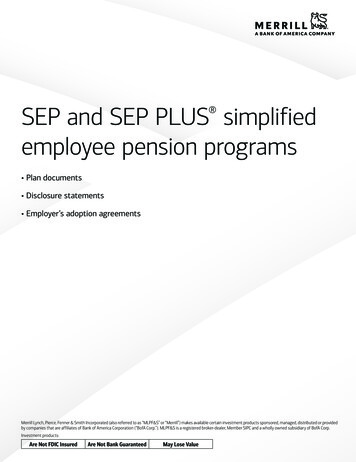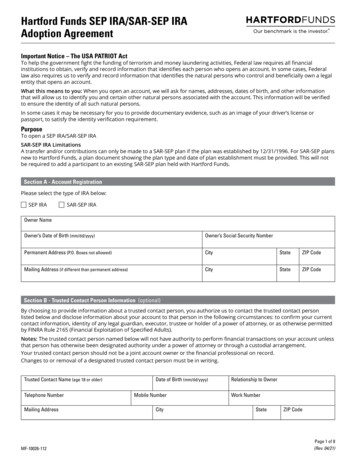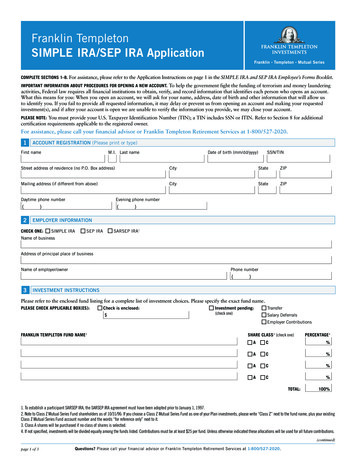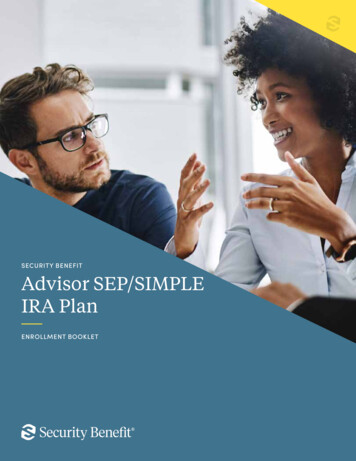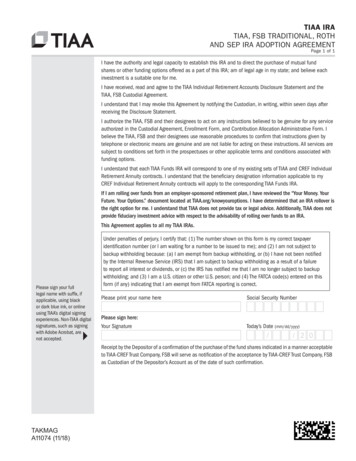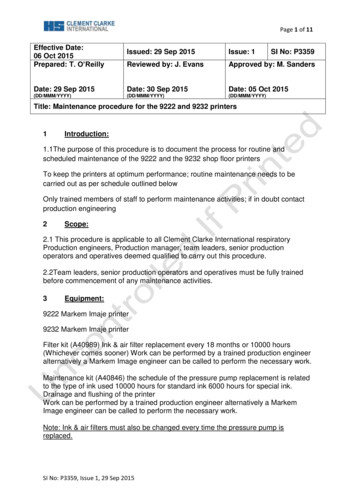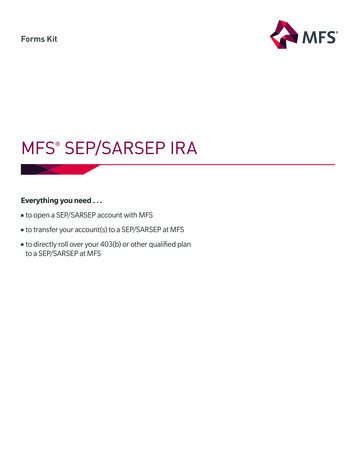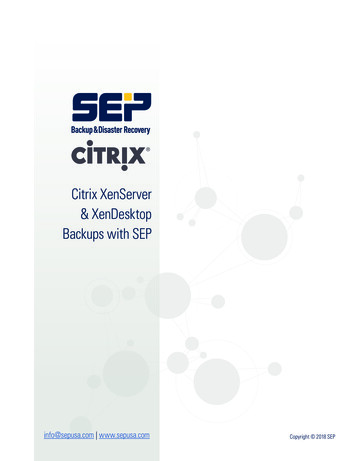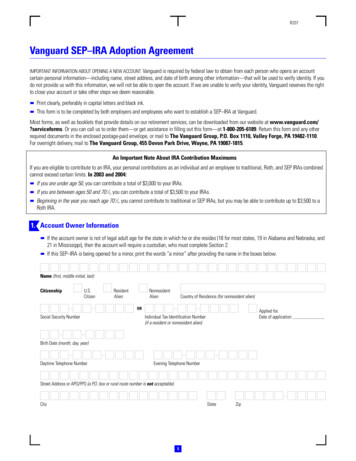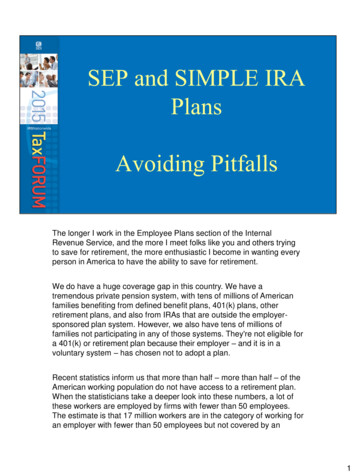
Transcription
The longer I work in the Employee Plans section of the InternalRevenue Service, and the more I meet folks like you and others tryingto save for retirement, the more enthusiastic I become in wanting everyperson in America to have the ability to save for retirement.We do have a huge coverage gap in this country. We have atremendous private pension system, with tens of millions of Americanfamilies benefiting from defined benefit plans, 401(k) plans, otherretirement plans, and also from IRAs that are outside the employersponsored plan system. However, we also have tens of millions offamilies not participating in any of those systems. They're not eligible fora 401(k) or retirement plan because their employer – and it is in avoluntary system – has chosen not to adopt a plan.Recent statistics inform us that more than half – more than half – of theAmerican working population do not have access to a retirement plan.When the statisticians take a deeper look into these numbers, a lot ofthese workers are employed by firms with fewer than 50 employees.The estimate is that 17 million workers are in the category of working foran employer with fewer than 50 employees but not covered by an1
employer-sponsored plan.And that brings us to today's discussion. There are two popular plan typesavailable to small business employers that they can adopt and cut into this 17million number. The first one is called a SEP, or a Simplified EmployeePension plan. The SEP plan allows plan sponsors to contribute to traditionalIRAs set up for the employees. And a self-employed business can adopt aSEP.The other plan I will discuss today is the SIMPLE IRA plan. "SIMPLE" standsfor Savings Incentive Match Plan for Employees. The SIMPLE IRA plan isideally suited as a start-up retirement plan for small business employers whocurrently do not sponsor a retirement plan.What I'm gonna do today is take you on a tour of both plans, providing to youthe similarities and differences when it comes time to choose and establishone of these plans. Then the tour will continue to discuss about theparticipation requirements of both plans. And finally, as the title suggests, we'llget into the pitfalls or the recurring errors that we find in our examinations ofthese plans. I will do my best to describe each error and then share with youhow to find, fix, and avoid these common errors.By the end of this presentation, I hope that you will leave the session, contactyour clients about choosing and establishing one of these plans, and thenassist them in ensuring their plan does not have the recurring errors wediscuss here today. And before I move on, if you do not have a retirement planfor yourself or your employees, lead by example and adopt one of these planswhen you return to your office.1
We'll start with choosing between a SEP and a SIMPLE IRA plan. ASEP plan is available to any sized business, while a SIMPLE IRA isgenerally limited to small businesses with 100 or fewer employees. Agrowing business with a SIMPLE IRA plan needs to watch that 100employee limit closely as they expand.To adopt a SEP or a SIMPLE IRA, we make it very easy. During thispresentation, I'm going to be saying "we make it very easy" a lot, reasonbeing we really want these employers to adopt these plans, so weprovide a lot of ways to make things easy for them to establish, monitor,and run these plans.So for a SEP, there is a Form 5305-SEP, called Simplified EmployeePension – Individual Retirement Accounts Contribution Agreement. Allthey have to do is adopt that, it's on our website, and it's done. ForSIMPLE IRA plans, they can adopt the 5305-SIMPLE if they want theemployer to choose where the money is initially deposited, or they canuse the Form 5304-SIMPLE to set up the SIMPLE IRA plan that allowseach employee to choose where the IRA is established.2
A couple of notes about these forms. First, these forms are not filed with theIRS. The employer keeps the form in its records. Second, with regard to theForm 5305-SEP, our exam agents are noticing a recurring error in their recentaudits. If you choose to use the Form 5305-SEP, you cannot have any otherretirement plan, except for another SEP. When an employer adopts a SIMPLEIRA plan, the employer cannot have any other retirement plan regardless ofthe method used to start the plan.An employer can also establish a SEP or SIMPLE IRA with a prototype planthrough a mutual fund, bank, and insurance company. This financial institutionwill send a plan in to us, the IRS. We approve it. Then they'll go out and try tosell it to you and your clients to have a prototype plan, and that's what that iscalled. There is also an individually designed SEP or SIMPLE IRA plan, but wedon't see too much of those. Those are very rare.The reason why people use a prototype document or an individually designedplan rather than the models, the employer can customize their SEP or SIMPLEIRA more the way they would like it.For both of these plan types, there are no filing requirements. You do not file aForm 5500-series return. Employee contributions are not allowed with SEPplans. SIMPLE IRA plans do allow employee contributions, which I will detailwhen we reach the operating portion of the tour.2
The next stop arrives at explaining the procedures to set up theseplans, and for the most part the procedures are very similar for bothplans. First the employer needs to select a financial institution to serveas the trustee of respective IRAs that will hold each employee'sretirement plan assets. These accounts will receive the contributionsyou make to the plan.Now, I mentioned the election period. That is a 60-day periodimmediately preceding January 1st, the beginning of the next plan year.So in essence, that would be November 2nd to December 31st.However, the dates of this period are modified if you set up a SIMPLEIRA plan in midyear or if the 60-day period falls before the first day anemployee becomes eligible to participate in the SIMPLE IRA plan.Again, to make things easy, if you set up your SIMPLE IRA plan eitherusing the Form 5304-SIMPLE or the Form 5305-SIMPLE models, youcan give each employee a copy of the signed form and that'll satisfy thisnotification requirement.The timing to set up these plans is different. You can establish a SEP3
for a year, as late as the due date, including any extensions, of your businessincome tax return for the year you want to establish the plan.Setting up a SIMPLE IRA plan is a little more complex. You can set up aSIMPLE IRA plan effective on any date from January 1st through October 1stof the year. To have a SIMPLE IRA in place for January 1st, 2016, it must beadopted by November 2nd, 2015, to accommodate the 60-day election period.If you previously maintained a SIMPLE IRA plan, you can set up a SIMPLEIRA plan effective only on January 1st of a year.One difference here would be if the employer chooses to adopt the plan usingthe 5304-SIMPLE, which allows each participant to select the financialinstitution for receiving his or her SIMPLE IRA plan contributions. Financialinstitutions authorized to hold and invest SEP and SIMPLE IRA plancontributions are banks, savings and loan associations, insurance companies,certain regulated investment companies, federally-insured credit unions, andbrokerage firms.The next required item to do for both plans is execute a written agreement toadopt a plan, and that's what we just discussed. You can use the Form 5305SEP, 5304-SIMPLE, 5305-SIMPLE, or prototype plan.The next requirement is to notify the eligible employees about the plan. For aSEP plan, the employer is required to notify each eligible employee that theSEP was adopted, the requirements for receiving an allocation, and how theemployer contribution will be allocated.You must also provide the following to each employee: the Form 5305-SEP, ifthat's what you use to adopt the plan; a statement that IRAs other than the onethe employer contributes to may provide different rates of return and containdifferent terms; a statement that the administrator of the SEP will provide acopy of any amendments within 30 days of the effective date, along with awritten explanation of its effects. And the administrator will give writtennotification to the participant of any employer contributions made to theparticipant's IRA by January 31st of the following year.For SIMPLE IRA plans, they're required to have an annual notice for all eligibleemployees. The employer must notify each employee before the beginning of3
the election period of the following: the employee's opportunity to make orchange a salary reduction choice under the SIMPLE IRA plan; the employee'sability to select a financial institution that will serve as trustee of theemployee's SIMPLE IRA if that's applicable; your decision to make eithermatching contributions or nonelective contributions; a summary description(and the financial institution usually provides that); and written notice that theemployee can transfer his or her balance without cost or penalty if you areusing a designated financial institution.3
I'm now going to discuss the participation requirements of these plans,and I'll start with the SEP plans. An eligible employee for a SEP plan isan individual who meets all of the following requirements: has reachedage 21; has worked for the employer in at least three of the last fiveyears; and received at least 600.00 in compensation from theemployer during the year.Two items tonight with this definition. First, employees also include aself-employed individual, and the 600.00 amount is for this year, 2015.Cost-of-living adjustments could change this amount from year to year.Around mid-October they release any cost-of-living adjustments. Youcan go to our website to see any changes to any amounts such as this.To further explain the SEP requirement, allow me to introduce Sephora.Sephora is a freshman at Huxley University, where she is getting herdegree in hippology. Does anybody what hippology is? It's the study ofa horse. Now, Huxley University and a horse, what movie am Ireferencing? No Marx Brothers fans here, huh? Horse Feathers. Theprize goes back in the hopper, sorry.4
Sephora worked for Barney's Barns during her summer break in school in theyear 2011, 2012, and 2013, but never more than 34 days in any year. Sephoraturned 21 in July 2014. In August 2014, Sephora began working for Barney'son a full-time basis, and she earned 18,000.00 in 2014. So Sephora is aneligible employee for Barney's Barns' SEP for 2014 because she met theminimum age requirement, 21; she worked for Barney in three of the fivepreceding years; and she met the minimum compensation requirement for2014.For a SIMPLE IRA plan, the requirements are different. Any eligible employeewould be one who, one, earned at least 5,000.00 in compensation during anytwo years before the current calendar year and, two, expects to receive atleast 5,000.00 during the current calendar year. As in a SEP, an individualcan be a self-employed individual. Employers cannot impose any otherconditions for participating in a SIMPLE IRA plan, such as an age requirement.Now, both the SEP and the SIMPLE IRA can have less restrictiverequirements if they choose. For instance, an employer could have a minimumage of 18 in a SEP, or in a SIMPLE IRA they could make the compensation 2,000.00, they could make it 1.00. It's their choice.Both plans can also exclude certain classes of employees. And these are, one,employees covered by a union agreement and whose retirement benefits werebargained for good faith by the employees' union and the employer; and two,nonresident alien employees who do not have U.S. wages, salaries, or otherpersonal services compensation from the employer. This should be “to note”4
Our tour trolley now stops at the operating/maintaining features of theseplans, and, again, I'll begin with SEP plans. Let's begin with thecontribution amounts and limitations. Remember, no employeecontributions are permitted in SEP plans. Employer contributions foreach eligible employee is based only on the first 265,000.00 ofcompensation. Employers must contribute a uniform percentage of payfor every eligible employee. And for 2015, contributions are limited tothe lesser of 53,000.00 or 25 percent of compensation.For self-employed individuals, figuring your own SEP IRA contributiongets a little bit more complicated. Compensation is your net earningsfrom self-employment, less deductions due to contributions to your ownSEP IRA, and one-half of your self-employment tax. And, again, tomake things easy, we have a Publication 560, called Retirement Plansfor Small Business. And this provides detailed explanations andworksheets for these rules, and what I suggest is you use thispublication to determine your self-employed contribution amounts.There is no requirement that a SEP contribution is made in every year.When you do contribute, however, you must contribute to the SEP IRAs5
of all eligible participants, including employees who die or terminateemployment before the contributions are made. Also, contribution to SEPaccounts are always 100 percent vested or owned by the employee.Employer contributions to a SEP must be made by the due date, including anyextensions, for filing your federal income tax return for that year. Once yousend the SEP contributions to each eligible employee's IRA, that employeemakes all the investment decisions for his or her own account. SEPcontributions can be invested in stocks, mutual funds, money market funds,savings accounts, and other similar types of investments. Employees canmove their SEP IRA assets from one traditional IRA to another.Employees could take a distribution from their SEP IRA at any time.Withdrawals are taxable in the year received. If the participant makes awithdrawal before age 59.5, there is a 10 percent additional tax that generallyapplies. We do have a publication on our website – it's Publication 5036 – thatprovides a list of the exceptions to that 10 percent additional tax on earlydistributions. I advise you to go there to look at that to see if any exceptionsapply.I know the financial institutions my parents use are on top of the requiredminimum distribution rolls, sometimes referred to as RMD rolls. And they domake certain the required minimums are distributed to them. However, on ourexaminations, we do see where these RMD payments are not made. If you donot take the minimum distribution required, you may have to pay a 50, fivezero, excise tax on the amount distributed as required. And trust me, nobodywants to deal with that tax. So we suggest that you work with your financialinstitution to ensure these distributions are made as required.SEP contributions and earnings may be rolled over tax-free to other IRAs andretirement plans. Our website has another tool. It's a rollover chart. It doesn'thave a publication number. I suggest on our homepage, go into the searchengine and type in "rollover chart," and it will be the first thing that shows up.And it helps you determine whether you can roll over amounts from your SEPIRA and the plan types where the SEP IRA can receive a rollover. Participantloans are never permitted in SEP plans. But contributions can still be made forthe employees that have reached age 70.5 .Again, here is some filing and notice requirements and tips. Remember, the5
employer generally has no filing requirements, including the Form 5500-seriesreturn. Here's a friendly reminder not to include SEP contributions on theemployee's Form W-2. Instead, check the Retirement Plan box, Box 13. And,again, remember, the employer must provide notice to the employees, whichincludes the Form 5305-SEP or the prototype, any amendments, therequirements for receiving contributions, and the annual contributionstatement. Might be easier to have written “seventy and a half.”5
Now let's move over to look at the operation of a SIMPLE IRA plan.Again, you're gonna find some similarities and you're gonna find somedifferences that we discussed with SEP.The SIMPLE IRA is funded two ways: employee elective deferrals andemployer contributions, and we'll start with employer contributions. Theemployer must annually choose one of the two contribution methods.The employer could either make a fixed contribution of 2 percent of payfor all eligible employees, even for those who do not elect to defersalary into the plan, or they can match employee contributions dollar fordollar, 100 percent, up to 3 percent of compensation. The match can bereduced to as low as 1 percent, but no more than two calendar yearsout of the five.The second way a SIMPLE IRA is funded is through employee salarydeferrals. The amount the employee can defer for 2015 is 12,500.00.For employees age 50 or over, a catch-up contribution in the amount of 3,000.00 is allowed. There are salary deferral limits also for thoseemployees in more than one plan. The elective deferral limit for anemployee with more than one plan is 18,000.00. I suggest you visit our6
website for other limitations when employees are participating in more thanone plan.Some employers set up an automatic enrollment feature in a SIMPLE IRAplan. What the automatic enrollment feature allows, it allows the employer toautomatically deduct a fixed percentage or amount from the employee's wagesand contribute that to the SIMPLE IRA plan, unless the employee hasaffirmatively chosen to contribute nothing or to contribute a different amount.And these automatic enrollment payments qualify as elective deferrals.Employees have the option to elect to terminate their salary reductioncontributions to a SIMPLE IRA plan at any time. If they do so, the SIMPLE IRAplan may preclude them from resuming salary reduction contributions until thebeginning of the next calendar year. Employers that are making non-electiveemployer contributions must continue to make them on behalf of theseemployees.An employer's 3 percent match or 2 percent non-elective contribution isrequired to be deposited by the due date – again, with any extensions – forfiling your federal income tax return for the year. Employee salary reductioncontributions are required to be deposited within 30 days after the end of themonth for which the amounts would otherwise have been payable to theemployee in cash. For a self-employed person, the Schedule C filer, salaryreduction contributions must be deposited within 30 days of the end of the planyear, or January 30th.Withdrawal rules for SIMPLE IRA contributions and earnings are the same as Idescribed the SEP plans, with one minor difference. The 10 percent additionaltax increases to 25 percent if the withdrawal occurs within the first two years ofparticipation. Rollovers are permitted between one SIMPLE IRA to anotherSIMPLE IRA, tax free. A tax-free rollover may also be made from a SIMPLEIRA to an IRA that is not a SIMPLE IRA, but, again, only after two years ofparticipation in the SIMPLE IRA plan.Also, like SEP plans, loans are never permitted. And, again, there is no Form5500-series filing requirement. And the notification election period is, again,generally the 60-day period immediately preceding January 1st of the calendaryear, November 2nd to December 31st. And the dates of this period aremodified if you set up a SIMPLE IRA plan in midyear or if the 60-day period6
falls before the first day an employee becomes eligible to participate in theSIMPLE IRA plan.6
Now we enter the part of the tour that provides the recurring errors ourexamination agents are finding when they audit SEP and SIMPLE IRAplan. Again, I'll provide details as best as I can and give you tips how tofind, fix, and avoid these errors. The first part of this segment is themost common errors we find in both plans.The first error you see involves plans not being amended at all or nottimely. Specifically, there was a law passed called the Economic Growthand Tax Relief Reconciliation Act of 2001, comm
Nov 23, 2015 · Setting up a SIMPLE IRA plan is a little more complex. You can set up a SIMPLE IRA plan effective on any date from January 1st through October 1st of the year. To have a SIMPLE IRA in place for January
